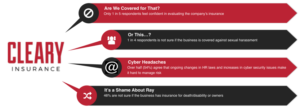Study Shows Majority of Boston Area Small Businesses Are Overexposed to Risk
56-percent of companies failed a business risk assessment, operating without basic safeguards against damage caused by cyber-attacks, HR issues and other common operational realities
This past summer, we conducted a study to see just how aware Boston area small business owners are of their overall insurance coverage. This was the first study of its kind; we call it the Cleary Small Business Risk Index.
The results were scary.

The Index shows that more than half (55%) of Boston area businesses failed a risk assessment that probed 19 areas of risk management including cyber security, professional liability, employment practices and more.
So what does this boil down to?

“This proved what we have always assumed – most business owners don’t understand how to properly assess or account for risk,” said Bill Cleary, president, Cleary Insurance. “The answer isn’t always ‘more insurance.’ There are many ways to offload, avoid or manage risk. But in order to succeed, you need to understand the basic situation, and too many business owners just don’t.”
The Boston-area wide survey (including businesses on the North Shore, South Shore and Metrowest) was conducted online questioning 100 business owners, operators and employees spanning a variety of industries including healthcare, retail, financial services, and more. All respondents had a significant influence on the operational decisions of each company.
Could you pass? Take the Cleary Small Business Risk Assessment today to test your understanding of coverage. Also, check back for the next few posts which outline and answer some of the greatest areas for risk.


 While all businesses should have a plan in place to protect their employees and their bottom line when a natural disaster hits, they should also consider their location and the insurance that is necessary to keep their doors open after a catastrophic event.
While all businesses should have a plan in place to protect their employees and their bottom line when a natural disaster hits, they should also consider their location and the insurance that is necessary to keep their doors open after a catastrophic event.